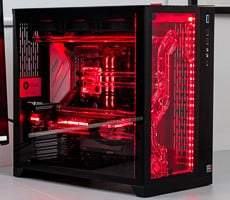Lenovo IdeaCentre Erazer X700 Gaming PC Review
This is a big system at 24.01 inches (L) by 10.62 inches (W) by 20.86 inches (H), and weighing north of 61 pounds. It's also decidedly more menacing in appearance than your standard desktop tower, leaving little doubt who the target audience is. Just in case further proof is needed, blue LEDs adorn the front and shine through the side panel's mesh window, flaunting the fact that this is a gaming box and not a number crunching machine for accountants, though it's certainly capable of doing your taxes just as a Dodge Challenger can be a grocery-getter.
|
| Processor: | Intel Core i7 3820 Quad-Core 3.6GHz (3.8GHz Turbo; 10MB cache) |
| Memory: | 12GB 1600MHz DDR3 (4GB x 3) |
| Graphics: | NVIDIA GeForce GTX 660 1.5GB GDDR5 |
| Chipset: | Intel X79 |
| Storage: | Samsung 128GB mSATA solid state drive Seagate Barracuda 1TB hard drive (7200 RPM, 64MB cache) |
| Optical: | DVD burner |
| Power Supply: | AcBel Polytech 625W |
| Cooling System: | Self contained liquid cooler |
| Connectivity: | Gigabit LAN; Wi-Fi (802.11b/g/n/) |
| Front Ports: | Power button; Overclocking button; USB 3.0 (x1); USB 2.0 (x1); Mic/Heaphone; 29-in-1 card reader |
| Rear Ports: | USB 3.0 (x2); USB 2.0 (x6); HDMI output; DisplayPort; DVI (x2) |
| Operating System: | Windows 8 64-bit |
| Accessories: | Keyboard and mouse |
| Dimensions: | 24.01 inches by 10.62 inches by 20.86 inches; 61.72 pounds |
| Warranty: | 1-year |
| Price: | $1,699.99 |
The configuration Lenovo sent us is its lowest end setup starting at $1,699 (we've seen Lenovo sell this system as low as $1,349 on its website with an eCoupon code). Interestingly, Lenovo opted for a Sandy Bridge-E foundation over Haswell, though it's hard to begrudge the raw performance Intel's Core i7 3820 quad-core processor brings to the table. At the same time, it sets a tone of compromise that continues with the NVIDIA GeForce GTX 660 graphics card selection rather than a higher end GPU, and 12GB of DDR3-1600 RAM spread across three modules in triple-channel mode as opposed to adding a fourth stick for quad-channel operation, which Intel's X79 chipset supports.
On the storage front, Lenovo paired a Samsung 128GB mSATA solid state drive with a Seagate Barracuda 1TB hard drive (7200 RPM, 64MB cache) for fast loads and sufficient space to hold a decent amount of data. None of this is cause for your jaw to fall to the floor, though higher end configurations are available, including a decked out system that costs $3,999.
One of the more interesting aspects of the Erazer X700 is an "Overclocking" button on the front panel that sits directly above the "Engine Start" button. When pressed, the Overclock button glows red and stays that way until you turn it off, though the system isn't necessarily overclocked at that point.
Lenovo includes a software utility that allows you to coax more performance out of the CPU without having to shuffle through the BIOS. You can only engage the software when the Overclocking button is pressed, at which point you can then adjust the CPU multiplier and other settings. Following a reboot, your settings will go into effect, assuming the system can handle the new parameters. If not, the motherboard catches fire, your system is ruined, and your wife runs off with the kids and dog leaving you to wonder how you could have been so careless (just kidding - it just reverts back to default settings).







